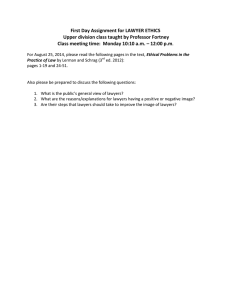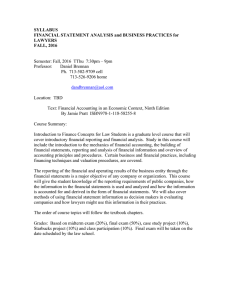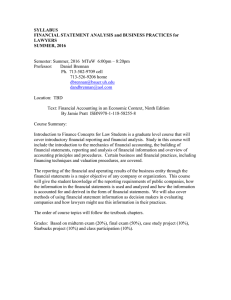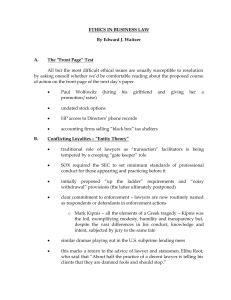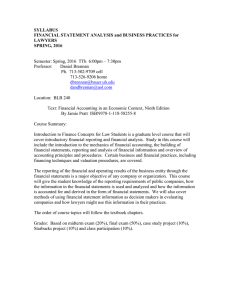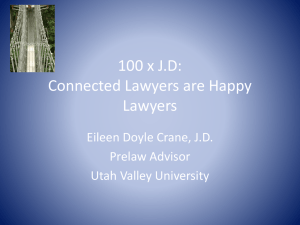Matthew 23:-
advertisement
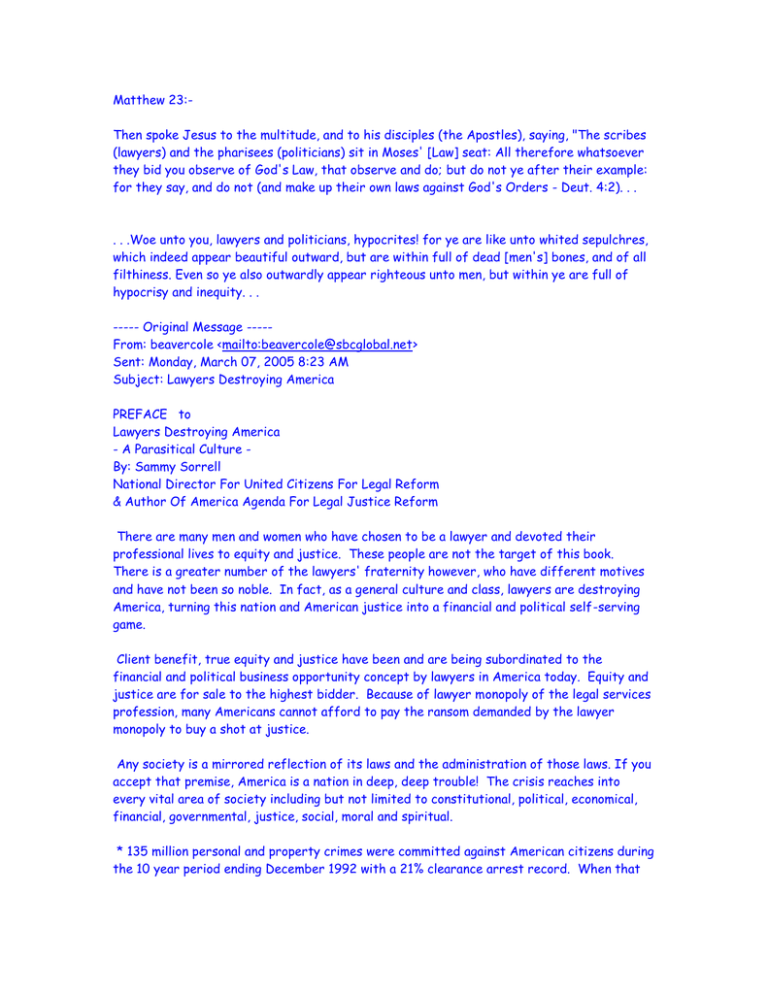
Matthew 23:Then spoke Jesus to the multitude, and to his disciples (the Apostles), saying, "The scribes (lawyers) and the pharisees (politicians) sit in Moses' [Law] seat: All therefore whatsoever they bid you observe of God's Law, that observe and do; but do not ye after their example: for they say, and do not (and make up their own laws against God's Orders - Deut. 4:2). . . . . .Woe unto you, lawyers and politicians, hypocrites! for ye are like unto whited sepulchres, which indeed appear beautiful outward, but are within full of dead [men's] bones, and of all filthiness. Even so ye also outwardly appear righteous unto men, but within ye are full of hypocrisy and inequity. . . ----- Original Message ----From: beavercole <mailto:beavercole@sbcglobal.net> Sent: Monday, March 07, 2005 8:23 AM Subject: Lawyers Destroying America PREFACE to Lawyers Destroying America - A Parasitical Culture By: Sammy Sorrell National Director For United Citizens For Legal Reform & Author Of America Agenda For Legal Justice Reform There are many men and women who have chosen to be a lawyer and devoted their professional lives to equity and justice. These people are not the target of this book. There is a greater number of the lawyers' fraternity however, who have different motives and have not been so noble. In fact, as a general culture and class, lawyers are destroying America, turning this nation and American justice into a financial and political self-serving game. Client benefit, true equity and justice have been and are being subordinated to the financial and political business opportunity concept by lawyers in America today. Equity and justice are for sale to the highest bidder. Because of lawyer monopoly of the legal services profession, many Americans cannot afford to pay the ransom demanded by the lawyer monopoly to buy a shot at justice. Any society is a mirrored reflection of its laws and the administration of those laws. If you accept that premise, America is a nation in deep, deep trouble! The crisis reaches into every vital area of society including but not limited to constitutional, political, economical, financial, governmental, justice, social, moral and spiritual. * 135 million personal and property crimes were committed against American citizens during the 10 year period ending December 1992 with a 21% clearance arrest record. When that 21% was turned over to the judicial system, the percentages went down. A sad commentary for the American justice system. *America has the highest tort tax in the world at $1200 for every man, woman and child. We cannot be competitive in the international market place. Who pays that tort tax? None other than the American consumer. * We are the most litigious society on earth with 95 million lawsuits filed annually at a cost exceeding $300 billion effecting the gross national product. * Over 80% of low to middle income Americans can no longer afford the cost of justice in America. * We have two standards of justice, the "Model T" brand and the "Cadillac brand". Those who have money get the Cadillac brand and those who don't have money go to prison or bankruptcy court. * Over 27 billion annually is extracted from the medical and insurance fields by lawyers looking to extort a settlement from the deep pockets in those professions. Billions more are being extracted from industry in asbestos litigation with 75% of the awards going to the lawyers. * We have laws and rules stacked end to end which would fill up the super dome in New Orleans. Yet we have a legal mentality that looks at a given dispute and says, "If we can't find any law that has been broken we may have to pass a new one." * We have a judicial system where politics, fraud, conspiracy, deception, perjury, dishonesty and obstruction of justice is the order of the day by the dominant lawyer culture who operate the system. This translates into a giant mirror for society that if it happens in the judicial system, you can get away with it in society. Is the judicial system teaching immorality on the face? Nobody is responsible, nobody is guilty, nobody is wrong as long as lawyers can make money out of the issue. Who is the keeper of the laws? There is no debate here! The answer is lawyers. Under the three branches of government concept, the answer spotlights a constitutional nightmare. The federal congress is dominated by lawyers and many of the state legislatures have been dominated by lawyers. Twenty four of the forty two American presidents have been lawyers - with two in the White house as of this writing. The judicial branch of government is 100% lawyer dominated. So what does this mean? If you don't get anything else from this book, remember this! It means we now have a ruling class of lawyers in the nation (1) making the laws, (2) judging us in the laws, (3) prosecuting us in the laws, (4) defending us in the laws, (5) interpreting the laws and (6) administering the laws. Not only is this an illegal monopoly of the vital legal services profession but it is profoundly a closed door tyrannical rule of the American people and a constitutional nightmare. It gets worse! Most of us have learned through our own experience in this life that truth and fact are the basis of all progress and anything less is deception with an effort in futility. Science did not put a man on the moon through distortion of fact and truth. Progress in the medical field has not been made because fact and truth has been disregarded. In any area of our lives, we really never know anything until we know it by its causes based upon fact and truth. The ruling class of lawyers controlling our nation has little regard for fact and truth. The entire lawyer profession is built around avoiding and redefining the truth. Their example of fraud, deception and dishonesty in society, in the judicial system, in government has sent a terrible negative-ethics message that has had a devastating effect on the character of generations of young people. These deceptive traits and practices are also the planks that support the foundation of the largest criminal culture to be found in any society. Law Schools are anti-ethics with teachings that there is no black or white situation, only a hundred shades of grey. Lawyers present a terrible conflict of interest on the face. Judges are lawyers with a robe on. When lawyers take the bench and don the robe, they do not leave behind all of their negative personal baggage and lawyer transgressions. The entire system is a lawyer closedmembership country club with the masses picking up the tab. Lawyers are social parasites-- they move to the soft and misery spots in the economy simply for personal financial or political gain at the expense of the parties. Lawyers are not producers--they gravitate to situations which will carve up and tear down the economy rather than build it up. The spoils from their mischief only benefit the lawyers personally and their political cohorts. A few, more noble minded lawyers with ethics notwithstanding. Lawyer self-regulation permits the judicial system to operate in a shroud of secrecy where lawyers can and do commit all manner of fraud and criminal transgressions and quickly hide those transgressions in a maze of lawyer self-regulation and protective rules. This includes blatant constitutional abuse and violations by lawyer-judges. Under this cloak, one lawyer with a briefcase can steal more than a thousand criminals with guns. Only 2% of all lawyer complaints nationwide are formally prosecuted. Lawyers gravitate to the political positions to dominate not only the judicial branch of government but also the legislative and executive branches of government. They have created a planet of needless laws where legalese has become the national language and technicalities have become the national product. All of this has a counter-productive effect on business and the free enterprise system. Lawyers should never be permitted to run a government. On more than one occasion we have put the nation's business on hold while the government spends millions looking into lawyer transgressions. The charges are generally made by lawyers against a lawyer. Look at the personal baggage of Bill and Hillary Clinton, an ongoing multi-million dollar investigation of two lawyers. A special lawyer was appointed to do the investigating. Lawyers in congress squabbling over congressional hearings where there will be more lawyers conducting those hearings with hundreds of staff lawyers behind the scenes shoving paper and pushing subpoenas. Lawyers standing by in courts to hear the evidence. Lawyers have undoubtedly cost this nation billions of dollars just in wasted motion, needless laws and judicial process in government, not to mention losses in the private sector. Lawyers have created an unconstitutional manufacturing plant that churns out laws by the hundreds daily. Under the constitution only congressional lawmakers are permitted to create law. Lawyer-judges create their own law daily in the judicial system based upon their own opinion and rulings and they call it case law. Upon these mountains of unconstitutional case law, people's lives and property and the constitution hang in the balance. Lawyers have created a monstrous legal monopoly of the entire legal services profession in America and then they create laws and rules so American citizens will be forced to use the monopoly. Litigants have to pay a ransom to a lawyer to access this monstrous legal monopoly just to open the court house door and then they often lose this front fee ransom through lawyer malpractice, conspiracy, fraud and theft. There are thousands, maybe millions, of documented cases where litigants have lost everything they own because of lawyer malpractice, conspiracy, fraud and theft. Lawyer-judges, prosecutors and other judicial bodies and tribunals (lawyers) have winked, blinked and nodded as they covered up the transgressions. Recently in Albuquerque, New Mexico the state district court handed down the largest judgement in history. That judgement was a whopping $21 million against a lawyer who handled a widow's trust estate, left by her deceased husband. After the husbands death, the lawyer withheld information from the woman about the value of the estate which ultimately grew to over $20 million dollars. All the while the woman was receiving $150 per month when she should have been receiving at least $78,000 per year in interest earned by the trust. She died in a rest home with her son having to borrow money to pay for her services. Where is the lawyer? Still in practice! Prosecutorial (lawyer) abuse is rampant. Political persecution under the guise of judicial prosecution is the order of the day with many lawyers in the state offices of District Attorney and Attorneys General. Many prosecutorial lawyers seek high profile cases and manipulate the media for name recognition as they climb the political ladder moving to a higher political office. A prosecutor victims graveyard stands as a monument to prosecutorial abuse in most states, created and maintained at the taxpayer expense. Bar associations, all lawyers literally operate the control tower of the Judicial system. Lawyer discipline is a joke. Lawyer misconduct, malpractice and lawyer theft are cloaked in a shroud of secrecy. Discipline is almost non-existent even in states where discipline is administered by a committee under the state supreme court. Dracula is in charge of the bloodbank! The truths in this book offer a singular focus evolving from lawyer domination and tyrannical dominion! From that lawyer domination flows many of the ills that not only have caused a failed equity and justice system but in large measure a destruction of the moral fiber of a great nation. It is the hope of the author that this exposure of the ruling class of lawyers in America, their mischief and destruction of a nation may cause a complacent society to rise up and say enough is enough. Hopefully, the reader may be enlightened that the very system designed to protect our rights and freedoms may have evolved into a monster that can easily take away those rights and freedoms through a nightmare of self-serving bureaucracy of lawyers. America became a great nation because of the great principles of its people, their morality, their interchange of faith in each other and in their God and because of a nation of procedures. If we are to remain great, it will be because we continue to build upon that same foundation. The dominant lawyer culture has taken us away from that foundation, creating a new foundation in negatives, politics, dishonesty, character assassination, fraud, deception, with no production of valuable goods and services. Because of their own selfserving interests and self ordination this nation is reaching new heights in immorality. We can ill afford to allow yesterday's immorality to become today's morality in such a vital part of our lives and watch it ripple out into society. But judge not upon my reflections! Let the documented stories and facts in this book decide the case. END To order the book Lawyers Destroying America call 1-888-666-9953 Ext. C2 -----Original Message----From: Steven Cord [mailto:stevecord@hotmail.com] Sent: Wednesday, March 23, 2005 11:39 AM To: comments@taxreformpanel.gov Subject: Empirical Supoort for the Most Ability-to-Pay Tax There Is ================I am appending below 60 brief summaries of empirical studies proving the advantages of a federal land value tax. >>>>>It is the most ability-to-pay tax there is, because most voters own little land value or have little land-rent income, especially if exemptions are granted to farmers, the elderly, the temporarily unemployed, etc. >>>>>If jobs are taxed, or what they produce is taxed (which comes to >>>>>the same thing), then there'll be fewer jobs. But not so with land values: if they are taxed, land-sites will have to be used more productively. That's good for the economy - for all of us. >>>>>This is how best to pay for a revenue shortfall in Social Security. But such a tax must be done carefully, and I could advise the Panel on that because I have had hands-on experience with it (I have induced 22 jurisdictions to do this). I request permission to present these studies (and more, if requested) to the Panel. =============Steven Cord (Professor-Emeritus, currently President, the Center for a Better Economy, 10528 Cross Fox Lane, Columbia MD 21044, 1-800-252-3126) 237 Report (1-60 only) by Steven B. Cord Dedicated to Allan Hutchinson of Australia and H. Bronson Cowan of Canada, who first devised and used the method for making empirical studies of LVT possible. This is a compendium of the first 60 of 237 empirical studies (there are many more) substantiating that land value taxation (hereafter abbreviated as LVT) has produced spurts in construction and renovation, as measured by building permits issued. It has taken me some 30 years to collect all these studies (they are from all over the world). Frankly, 237 studies may well be considered overkill. The sheer number and consistency of these findings is positively overwhelming; they surely suffice to show that we could gain at least these three advantages by taxing land assessments more, construction and renovation less: v Construction & renovation spurt because they are taxed less v They also spurt because all land-sites will be used more efficiently v Most people get tax breaks (because they don’t own valuable land). There are other LVT advantages also. The empirical studies reported here have been taken from back issues of Incentive Taxation (published eight times a year since 1974) but I only have reviewed about a quarter of those back issues. I stopped after #237, thinking that few people will read more. My files contain the additional studies beyond 237. A random 22 of these 237 studies have been reprinted in a new book, The Golden Key to Continuous Prosperity. I have encountered no anti-LVT empirical studies, despite a rather extensive reading of the academic literature. These studies have been fully corroborated by independent sources. For instance, before Fortune Magazine ran its 1983 article supporting LVT, it sent two researchers, Gurney Breckenfeld and Ed Baig, to visit the city halls that I had visited and found that the figures were exactly as I had reported them in Incentive Taxation. Professor Nicolaus Tideman of Virginia Tech. University and his then-graduate student, Florenz Plassman of Virginia Tech University (now a professor in Binghamton) replicated all these studies and published their research in the peer-reviewed Journal of Urban Economics (March 2000, pp. 216-47; see IT 12/00). A 1985 study by the prestigious Pennsylvania Economy League contained facts supporting the conclusions of this compendium (see p. 16 of their 1985 study). Later, the P.E.L. was instrumental in getting two cities (Clairton and DuBois, Pa.) to adopt a two-rate building-to-land shift in their property tax. Note also that Allan Hutchinson, the author of many of these studies, used government sources. He and H. Bronson Cowan of Canada (who visited Australia in 1943) discovered that the Australian Bureau of Statistics annually published the building permit issuance of every area in the country. I have also used building permits for my studies. Hutchinson was able to compare the performance of land taxing areas with their neighbors both before and after the adoption of LVT. The statistics came to him, he didn’t have to go to them! Perhaps this question has crossed your mind: “If LVT is so good, why hasn’t it been more widely adopted?” Well, if you don’t act after reading this tremendous mass of empirical evidence, then you have the answer. If a partial shift from taxing buildings to taxing land produced all these wonderful economic results, one can assume that a 100% LVT would do even better. You can order hard copies of this report for $12 (as of 2004) or you can request a free copy of a report containing the aforementioned 22 studies. Read at least some of these empirical studies and judge for yourself. Then act. (1) The accountancy firm of Price, Waterhouse & Co. performed a study for H.U.D., which found that tax abatement was conducive to new construction (per summary, p. 4, as reported in the summer 1975 issue of Incentive Taxation (hereafter referred to as IT). The study reported: “Based upon the evidence collected it appears that the Fairhope Single Tax Corporation’s practice of site value rental has been effective in that it has encourage more intensive development of its property” (p. 8). (2) In the early 1970s, the General Council for Rating Reform of Australia reported that in Kilmore Shire, Victoria, the dollar value of construction and renovation increased 3.19 times in the three whole years when it started to tax land values only, as compared to the three years previous when building and land income was taxed (based on statistics from the Australian Bureau of Census; local property-tax switches in Australia were made in April, so there was a year in which both systems applied. See IT, summer 1975). This GCRR study was based on statistics from the Australian Bureau of Census. It is important to note that local property-tax switches in Australia were made in April, so there was a year in which both systems applied. (3) In Buninyong Shire (Victoria), the GCRR found that, comparing the three whole years immediately prior to the shift from taxing the income of both building and land to the first two whole years after the shift when only the land value was taxed, there was an average 5.90 increase in the annual dollar value of new construction and renovation (Ibid.; the ultimate source was the Australian Bureau of Census).In Buninyong Shire (Victoria), the GCRR found that, comparing the three whole years immediately prior to the shift from taxing the income from both building and land to the first two whole years after the shift when only the land value was taxed, there was an average 5.90 increase in the annual dollar value of new construction and renovation (Ibid.; the ultimate source was the Australian Bureau of Census). (4) In Orbost Shire (also Victoria), the GCRR compared the three whole years before the shift to taxing land values only to the year immediately after the shift. It found that the average annual construction and renovation increased 1.74 times (ultimate source: Australian Bureau of Census). (5) Harry Gunnison Brown, a prominent American public-finance economist in the 1930s, found that those districts in the states of South Australia and Victoria which taxed land values were markedly superior in new dwelling construction. He also found that in the state of Victoria, “although at the 1921 census only 16 per cent of the state population was in the fourteen districts rating land values, these districts accounted for 46 per cent of the total increase in dwellings for the State between the two census years [1921 and 1933].” (6) Brown’s figures on the Melbourne suburbs were even more striking. He found that those suburbs which are about five rail miles from Flinders Street in the center of Melbourne and which tax land values only, had 50% more dwellings constructed per available acre in the 1928-1942 period than those which did not. Making a similar comparison for suburbs seven miles out, the land-value-tax suburbs did 2.33 times better; LVT suburbs 9.5 miles out did twice as well (IT, 9/75). (7) Melton Shire (Victoria) switched from taxing real-estate income to taxing only land values in 1973 (as the result of a poll of landowners only) and then saw the Aus. dollar value of its building permits increase 1.68 times in the first year after the switch as compared to the year previous (Land Values Research Group, successor to GCRR, hereafter referred to as LVRG) – IT 10/75. All of LVRG’s studies come from the Aus. Bureau of Census). (8) The average 1954-61 population growth of rural LVT towns in Victoria was 21.8%, but for their non-LVT neighbors it was only 13.4%. Their 1955-63 dwelling construction was 38.3% higher (source: GCRR, using Victoria state govt. statistics). (9) New York State taxpayers spent more than $400 million to build the New York Thruway, but land values along the route increased by considerably more than $400 million (Perry Prentice in Architectural Forum, as reported in IT 1-2/76). (10) Life editorial (1965): “Since the [Toronto] subway was built the neighborhoods around the stations have experienced a small construction boom and land values have skyrocketed. A 100square-foot plot purchased in 1947 for $22,000 sold ten years later for $257,000.” (IT, 1-2/76). (11) ”The landowners on Staten Island in New York City pocketed a $700 million windfall because other taxpayers put up $350 million for the Verrazano Narrows Bridge; now their land is much more accessible than before. And one can wonder about the increase in land valuation on the Brooklyn side of the bridge.” So wrote Perry Prentice, vice-president of Time, Inc., in an article in The Commercial and Financial Chronicle, 8/22/68, as reported in IT, 1-2/76. (12) In the seven years following the construction of New York City’s IRT subway from 135th St. to Spuyten Duyvil, the rise in land value was $69.3 million. Subtracting the normal increase during the previous seven years - $20.1 million – leaves an increase of $49.2 million directly attributable to the opening of the line. But that section of the line cost only $41.8 million (Gilbert Tucker, The Self-Supporting City, quoting a City Club study - see IT, 1-2/76). (13) According to one public official in New Jersey quoted by Gilbert Tucker in The SelfSupporting City, the opening of the George Washington Bridge in 1928 increased land values on just the New Jersey side by $300 million, or more than six times the original construction cost (IT, 1-2/76). (14) Less than two years after the property owners of Wangaratta (in Victoria, Aus.) had voted 4-1 to adopt LVT only, the following headline appeared in the local newspaper: “Building ‘Wave’ Envelops Whole of Town.” This occurred during a building recession in the general area (IT, 9/75). (15-30) Random-sample studies in sixteen U.S. cities substantiating that most homeowners pay less with a two-rate building-to-land property-tax shift IT 5-6-7/76). (31) Landowners in rural Mildura - pop. 11,000, 350 miles northwest of Melbourne in rural Victoria - voted in LRT-only in August 1956 by a 3.6:1 margin. The value of building permits thereupon rose by one-third in 1957 and by another third in 1958 in the face of a 10% house-building recession in rural Victoria during those years (source: Aus. govt. statistics as quoted in Progress 11/59). See IT, 1/78. (32) “As a means of encouraging owners of sub-standard dwellings to install improvements, the City of New York adopted in 1936 a law granting property-tax exemption for five years upon the value added to existing buildings by improvements completed before October 1, 1938, provided the improvements did not increase the size of the building. Mayor LaGuardia estimated that renovation work in that year ran as high as $75,000,000…” (source: Harold S. Buttenheim, founding editor of the American City Magazine -see IT 11/76). (33) A Pittsburgh City Council study showed conclusively that a 1% earned income tax would hit the city’s homeowners 3.59 times harder than an equivalent-in-revenue LVT increase. The same study also found that a two-rate LVT would down-tax 73.6% of homeowners (IT 12/76). (34) Then there’s Horsham (a city in rural Victoria, Aus.). To quote from Progress, 6/74 (an Australian monthly magazine): “Horsham made the change to site value rating during the rural recession. For the three years before the un-taxing of buildings, the numbers and values of permits issued to private homebuilders had fallen drastically (from $718,000 down to $418,000 immediately before the change). “This is almost double the numbers of approvals and almost triple their values of the last year of taxed buildings. Site value rating has done much to beat the rural recession in this area.” (source: Australian government building-permit statistics, as reported in IT 12/76). This ends our examination of the first bound volume of Incentive Taxation (there are nine such volumes). This first volume covers a period before many two-rate building-to-land shifts occurred in the United States, and so in these early studies, Incentive Taxation had to rely primarily on statistics of the impact of such a tax shift from distant Australia. (35) A Washington, D.C. study done in the 1970s shows that if the current property tax were shifted from land and building assessments to land assessments only, then there would be these tax reductions: single-family homes – 18.1%, two-family homes – 20.9%, row houses – 14%, walkup apartments – 38.9%, elevator apartments – 22.5% (IT W/77). (36) From 1921 to 1933, 7% of the municipalities in Victoria, Aus. taxed only land values, but they accounted for 46% of home construction. In the years 1947-54, the LVT municipalities had increased to 12%, but they accounted for 42% of the home construction. During 1954-58, 19% were using LVT, but they accounted for 62% of new home construction (source: building-permit issuance per GCLR). See 1T, 10/77. (37) In 164 localities outside Melbourne, Aus., during the two-year period 1955/56 to 1957/58, there were 42 new factories, of which half were in the 17 localities using LVT-only. Not only that, but factory employment in these 17 LVT-only localities increased by 445 whereas in the remaining 147 localities, factory employment decreased by 361 (source: Aus. govt. statistics in “Public Charges Upon Land Values,” a 1961 study of the GCLR). See IT, 1077. (38-49) Twelve studies in rural Victoria show that LVT-only towns averaged a construction-andrenovation growth of 29%, as against their land-and-building-taxing neighbors’ growth of a modest 2.6% in the same periods of time (source: GCLR study of building-permits issued as reported in Progress, 3/75). LVT-only was adopted in each case as a result of a poll of only landowners (see IT, 10/77). (50) Wellington, New Zealand taxed land values while Auckland did not. In 1965, Wellington had £219 in improvements for every £100 in land value while Auckland had only £143 in improvements per £100 in land value (source: N.Z. govt. statistics per GCLR). See IT, 10/77. (51) LVT-only Sydney and real-estate-taxing Melbourne in Australia could be compared in this way. In 1965, Sydney had £222 in improvements for every £100 values whereas Melbourne had only £125 in improvements for every £100 in land values (source: GCLR using the Aus. govt.’s ABS; see IT, 10/77).LVT-only Sydney and building-taxing Melbourne in Australia could also be compared in this way. In 1965, Sydney had £222 in improvements for every £100 values whereas Melbourne had only £125 in improvements for every £100 in land values (source: GCLR, ABS – Aus. govt.), see IT, 10/77. (52) Ken Synett (former mayor of Marion, Aus): “For many years the Marion area remained static. Much of the land now being developed was in the hands of speculators. “They held it as a lock-up investment. Tax rates were low…Then in 1954, the year after we achieved city status, our rating system was changed from a rental basis [i.e., real-estate-income tax] to one based on unimproved land value [LVT]. This sent the tax rates up [on land values]…The land investors decided it was time to sell…We are now watching Marion’s phenomenal expansion with pride.” See IT, 10/77. (53) After Camberwell, a suburb of Melbourne, Australia, adopted LVT-only in 1922, its development was meteoric. For twenty years, it headed the Victoria building-development figures both in numbers and values until displaced by Moorabin in 1946 after that city also changed to LVT-only. In addition, Camberwell exhibited another advantage of LVT-only – it was fully in accord with ability-to-pay (source: Progress per LVRG, using Aus. govt. statistics; see chart in IT, 11/77. (54) A 1965 study sponsored by the California General Assembly (prepared by Griffin, Hagen and Kroger) revealed that over 92% of the homeowners and renters in Fresno, CA would get tax reductions with a building-to-land tax shift. See IT 12/77. (55-59) A GCLR study of five towns in rural Victoria, Australia between 1965 and 1966 showed that they exceeded the construction growth of their neighbors by 18%, 23%, 52%, 66%, and 48%. (60) In November 1964, the property owners of South Melbourne (Aus.) voted in a switch to the LVT-only system. In the first six months of 1965, building values increased 2.4 times over what it had been in the four preceding six-month periods. The expenditures for alterations and additions to houses were 2.8 times the average in the four preceding six-month periods. The total value of construction permits for industrial buildings increased 3.3 times. Not only that, but the growth in construction continued unabated in the ensuing years (source: Aus. govt. statistics per GCLR). Many decades ago, South Melbourne had been a fashionable spot in the Melbourne area. Then it ran down, went to seed. After switching to LVT-only, it revived and became known as the “Cinderella City.” The Melbourne Herald (12/2/72) called its renaissance “The Kiss of Life” (headline). See IT, 1/78.
